Biomass-Derived Plant Extracts in Macromolecular Chitosan Matrices as a Green Coating for PLA Films
Abstract
1. Introduction
2. Materials and Methods
2.1. Materials
2.1.1. Plant Material
2.1.2. Chemicals and Reagents
2.1.3. Solution Preparation
Preparation of Macromolecular Solutions of Primary and Quaternary Chitosan
Preparation of the TPP Solution
Preparations of Different Extract Solutions
Preparation of Particles with Embedded Extracts
Application of Formulations to PLA Films
2.2. Methods
2.2.1. Determination of Zeta Potential (ZP) and Hydrodynamic Diameter (HD)
2.2.2. Goniometry
2.2.3. ATR-FTIR Spectroscopy
2.2.4. Surface Elemental Composition—XPS Analysis
2.2.5. Scanning Electron Microscopy—SEM
2.2.6. Desorption Study
2.2.7. Antioxidative Activity
ABTS Assay
DPPH Assay
2.2.8. Antimicrobial Activity
2.2.9. Statistical Analysis
3. Results and Discussion
3.1. Particle Size and Zeta Potential Determination
3.2. Goniometry
3.3. ATR-FTIR Spectroscopy
3.4. ATR-FTIR Spectroscopy after Desorption
3.5. XPS
3.6. SEM Analysis
3.7. Antioxidant Efficiency of Functionalised PLA Films
3.8. Antimicrobial Activity
4. Conclusions
Author Contributions
Funding
Institutional Review Board Statement
Informed Consent Statement
Data Availability Statement
Conflicts of Interest
References
- Circular Economy in Europe, towards a new economic model. In The European Files; Ellen Macarthur Foundation: Cowes, UK; McKinsey Center for Business and Environment: New York, NY, USA, 2015.
- Foundation, E.M. Growth Within: A Circular Economy Vision for a Competitive Europe; Ellen Macarthur Foundation: Cowes, UK, 2015. [Google Scholar]
- Ronzon, T.; Piotrowski, S.; Tamosiunas, S.; Dammer, L.; Carus, M.; M’barek, R. Developments of Economic Growth and Employment in Bioeconomy Sectors across the EU. Sustainability 2020, 12, 4507. [Google Scholar] [CrossRef]
- Crawford, R.J.; Martin, P. Plastics Engineering; Elsevier: Amsterdam, The Netherlands, 2020. [Google Scholar]
- Geyer, R.; Jambeck, J.; Law, K. Producción, uso y destino de todos los plásticos jamás fabricados. Sci. Adv. 2017, 3, 1207–1221. [Google Scholar]
- Phelan, A.A.; Meissner, K.; Humphrey, J.; Ross, H. Plastic pollution and packaging: Corporate commitments and actions from the food and beverage sector. J. Clean. Prod. 2022, 331, 129827. [Google Scholar] [CrossRef]
- Plastic Pollution Is Growing Relentlessly as Waste Management and Recycling Fall Short, Says OECD. Available online: https://www.oecd.org/environment/plastic-pollution-is-growing-relentlessly-as-waste-management-and-recycling-fall-short.htm (accessed on 27 June 2022).
- Sardarodiyan, M.; Mahdian, E. Active packaging systems for a modern society. Int. J. Pharm. Tech. Res 2016, 9, 357–363. [Google Scholar]
- Wyrwa, J.; Barska, A. Innovations in the food packaging market: Active packaging. Eur. Food Res. Technol. 2017, 243, 1681–1692. [Google Scholar] [CrossRef]
- Bastarrachea, L.J.; Wong, D.E.; Roman, M.J.; Lin, Z.; Goddard, J.M. Active packaging coatings. Coatings 2015, 5, 771–791. [Google Scholar] [CrossRef]
- Muxika, A.; Zugasti, I.; Guerrero, P.; de la Caba, K. Applications of Chitosan in Food Packaging. In Reference Module in Food Science; Elsevier: Amsterdam, The Netherlands, 2017. [Google Scholar]
- Elsabee, M.Z.; Abdou, E.S. Chitosan based edible films and coatings: A review. Mater. Sci. Eng. C 2013, 33, 1819–1841. [Google Scholar] [CrossRef]
- Jonaidi Jafari, N.; Kargozari, M.; Ranjbar, R.; Rostami, H.; Hamedi, H. The effect of chitosan coating incorporated with ethanolic extract of propolis on the quality of refrigerated chicken fillet. J. Food Process. Preserv. 2018, 42, e13336. [Google Scholar] [CrossRef]
- European Biomass Industry Association. Bio-Based Products. Available online: https://www.eubia.org/cms/wiki-biomass/bio-based-products/ (accessed on 16 October 2022).
- Zemljič, L.F.; Plohl, O.; Vesel, A.; Luxbacher, T.; Potrč, S. Physicochemical characterization of packaging foils coated by chitosan and polyphenols colloidal formulations. Int. J. Mol. Sci. 2020, 21, 495. [Google Scholar] [CrossRef]
- Barbieri, F.; Montanari, C.; Šimat, V.; Skroza, D.; Čagalj, M.; Smole-Možina, S.; Bassi, D.; Gardini, F.; Tabanelli, G. Effects of Rubus fruticosus and Juniperus oxycedrus derivatives on culturability and viability of Listeria monocytogenes. Sci. Rep. 2022, 12, 13158. [Google Scholar] [CrossRef]
- Glaser, T.K.; Plohl, O.; Vesel, A.; Ajdnik, U.; Ulrih, N.P.; Hrnčič, M.K.; Bren, U.; Fras Zemljič, L. Functionalization of polyethylene (PE) and polypropylene (PP) material using chitosan nanoparticles with incorporated resveratrol as potential active packaging. Materials 2019, 12, 2118. [Google Scholar] [CrossRef]
- Potrč, S.; Kraševac Glaser, T.; Vesel, A.; Poklar Ulrih, N.; Fras Zemljič, L. Two-layer functional coatings of chitosan particles with embedded catechin and pomegranate extracts for potential active packaging. Polymers 2020, 12, 1855. [Google Scholar] [CrossRef] [PubMed]
- ISO 22196:2007; Plastics—Measurement of Antibacterial Activity on Plastics Surfaces. ISO: Geneva, Switzerland, 2007.
- Chevallier, P.; Turgeon, S.; Sarra-Bournet, C.; Turcotte, R.; Laroche, G. Characterization of multilayer anti-fog coatings. ACS Appl. Mater. Interfaces 2011, 3, 750–758. [Google Scholar] [CrossRef] [PubMed]
- Kaminski, K.; Szczubiałka, K.; Zazakowny, K.; Lach, R.; Nowakowska, M. Chitosan derivatives as novel potential heparin reversal agents. J. Med. Chem. 2010, 53, 4141–4147. [Google Scholar] [CrossRef] [PubMed]
- Rwei, S.-P.; Chen, Y.-M.; Lin, W.-Y.; Chiang, W.-Y. Synthesis and rheological characterization of water-soluble glycidyltrimethylammonium-chitosan. Mar. Drugs 2014, 12, 5547–5562. [Google Scholar] [CrossRef] [PubMed]
- Xiao, B.; Wan, Y.; Wang, X.; Zha, Q.; Liu, H.; Qiu, Z.; Zhang, S. Synthesis and characterization of N-(2-hydroxy) propyl-3-trimethyl ammonium chitosan chloride for potential application in gene delivery. Colloids Surf. B Biointerfaces 2012, 91, 168–174. [Google Scholar] [CrossRef] [PubMed]
- Aly, A.A.; Ali, H.G.; Eliwa, N.E. Phytochemical screening, anthocyanins and antimicrobial activities in some berries fruits. J. Food Meas. Charact. 2019, 13, 911–920. [Google Scholar] [CrossRef]
- Ibrahim, E.H.; Kilany, M.; Ghramh, H.A.; Khan, K.A.; ul Islam, S. Cellular proliferation/cytotoxicity and antimicrobial potentials of green synthesized silver nanoparticles (AgNPs) using Juniperus procera. Saudi J. Biol. Sci. 2019, 26, 1689–1694. [Google Scholar] [CrossRef] [PubMed]
- Wizi, J.; Ni, L.; Darkwah, W.K.; Xianglan, L. Analysis of Bioactive Compounds from Different Algae Samples Extracted with Ultrasound: Characterizations, Phytochemical Contents and Antioxidant Potentials. Pharmacogn. Res. 2022, 14, 35–44. [Google Scholar] [CrossRef]
- Chieng, B.W.; Ibrahim, N.A.; Yunus, W.M.Z.W.; Hussein, M.Z. Poly(lactic acid)/Poly(ethylene glycol) Polymer Nanocomposites: Effects of Graphene Nanoplatelets. Polymers 2014, 6, 93–104. [Google Scholar] [CrossRef]
- Kwiatkowski, P.; Giedrys-Kalemba, S.; Mizielińska, M.; Bartkowiak, A. Modification of PLA foil surface by ethylcellulose and essential oils. J. Microbiol. Biotechnol. Food Sci. 2021, 2021, 440–444. [Google Scholar] [CrossRef]
- Nasri, N.; Tlili, N.; Elfalleh, W.; Cherif, E.; Ferchichi, A.; Khaldi, A.; Triki, S. Chemical compounds from Phoenician juniper berries (Juniperus phoenicea). Nat. Prod. Res. 2011, 25, 1733–1742. [Google Scholar] [CrossRef] [PubMed]
- Meena, N.K.; Chauhan, K.; Meghwal, M.; Jayachandran, A. Plant extracts as nutrient enhancers. In Plant Extracts: Applications in the Food Industry; Elsevier: Amsterdam, The Netherlands, 2022; pp. 143–164. [Google Scholar]
- Cano, A.; Acosta, M.; Arnao, M. A method to measure antioxidant activity in organic media: Application to lipophilic vitamins. Redox Rep. 2000, 5, 365–370. [Google Scholar] [CrossRef] [PubMed]
- Prior, R.L.; Wu, X.; Schaich, K. Standardized methods for the determination of antioxidant capacity and phenolics in foods and dietary supplements. J. Agric. Food Chem. 2005, 53, 4290–4302. [Google Scholar] [CrossRef]
- Martysiak-Żurowska, D.; Wenta, W. A comparison of ABTS and DPPH methods for assessing the total antioxidant capacity of human milk. Acta Sci. Pol. Technol. Aliment. 2012, 11, 83–89. [Google Scholar]
- Kong, M.; Chen, X.G.; Xing, K.; Park, H.J. Antimicrobial properties of chitosan and mode of action: A state of the art review. Int. J. Food Microbiol. 2010, 144, 51–63. [Google Scholar] [CrossRef]
- Burt, S. Essential oils: Their antibacterial properties and potential applications in foods—A review. Int. J. Food Microbiol. 2004, 94, 223–253. [Google Scholar] [CrossRef]
- Oonmetta-aree, J.; Suzuki, T.; Gasaluck, P.; Eumkeb, G. Antimicrobial properties and action of galangal (Alpinia galanga Linn.) on Staphylococcus aureus. LWT-Food Sci. Technol. 2006, 39, 1214–1220. [Google Scholar] [CrossRef]

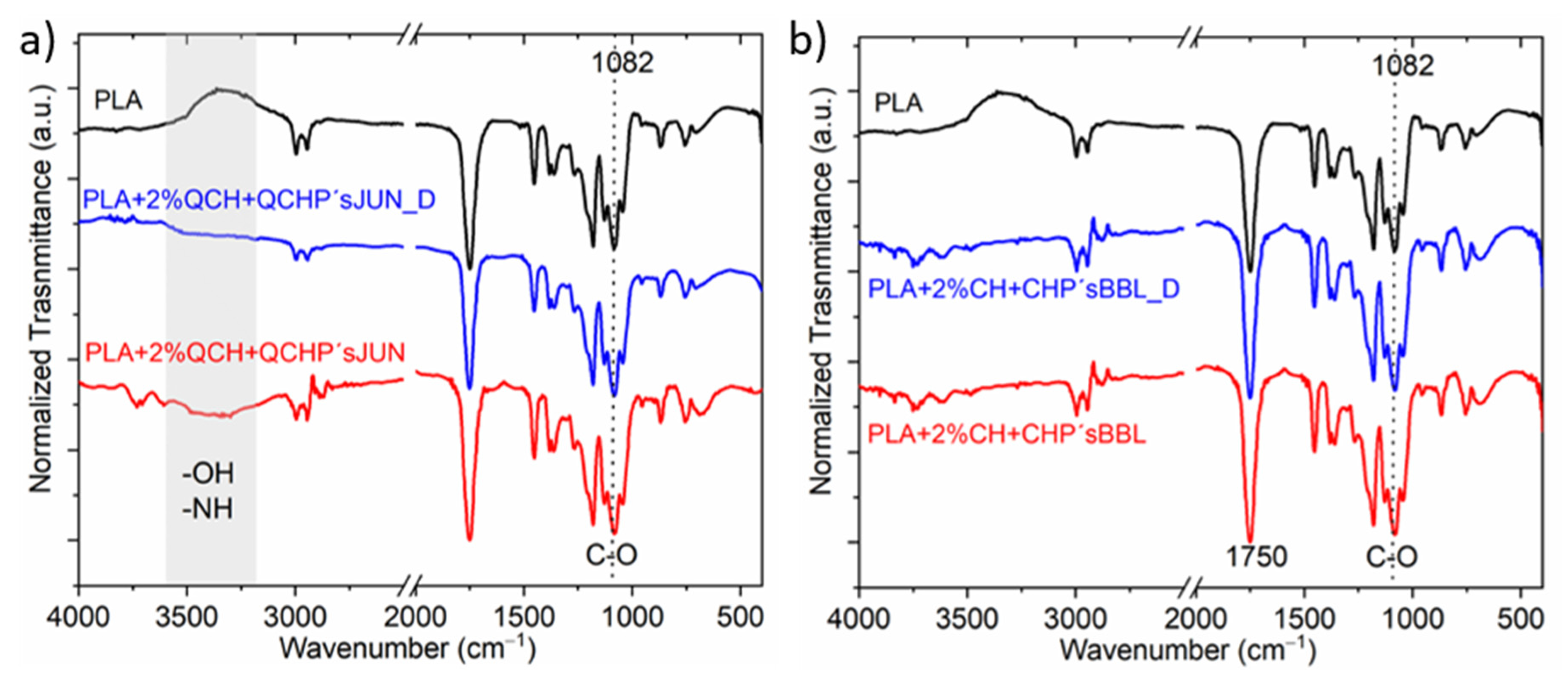
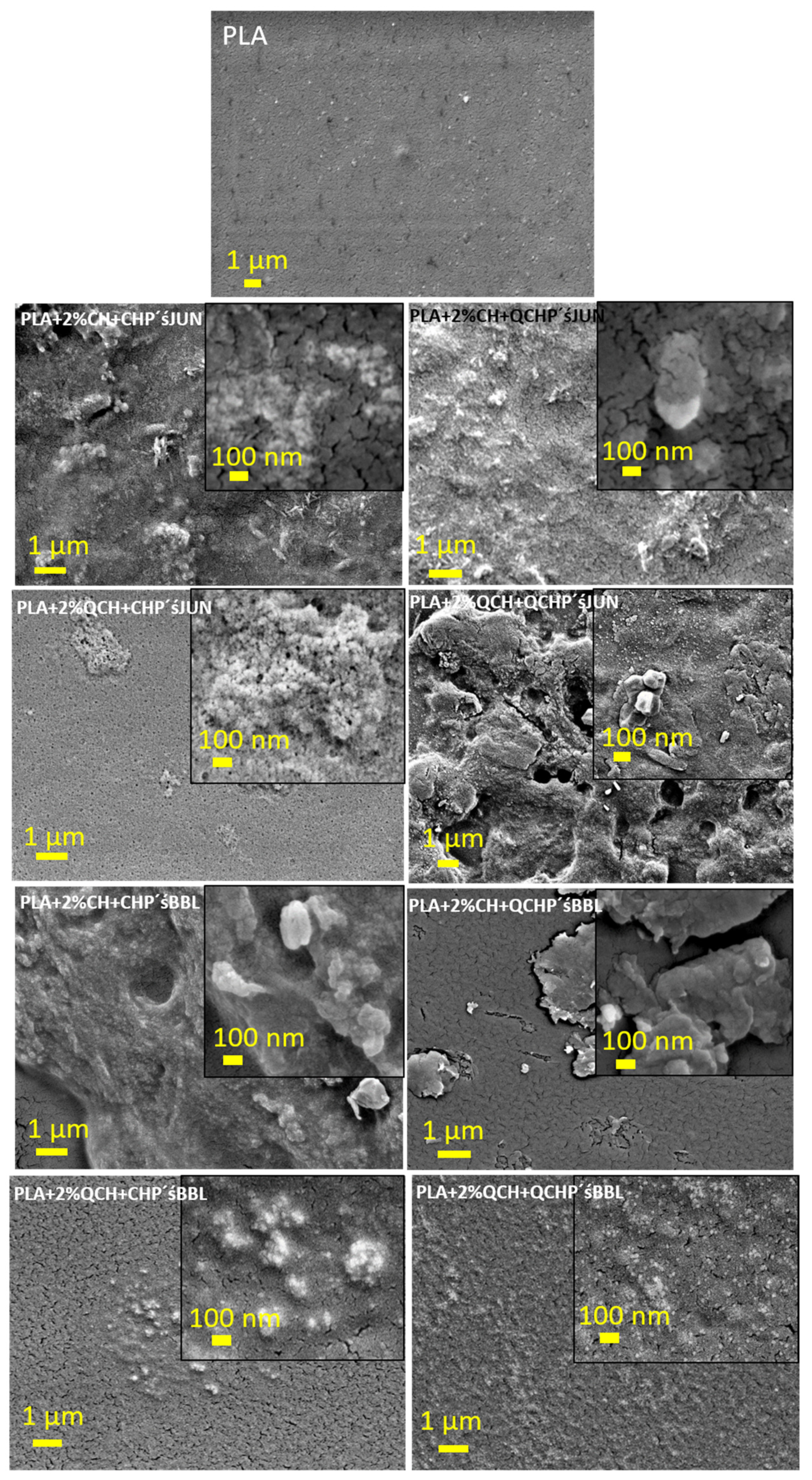
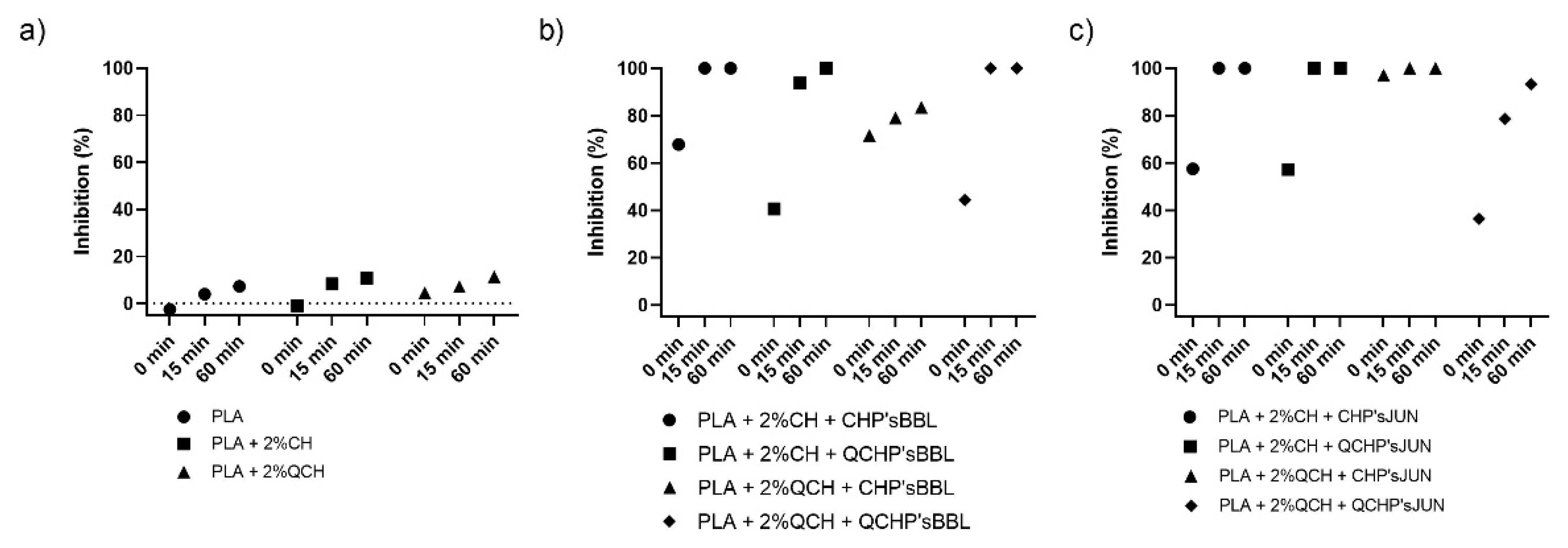
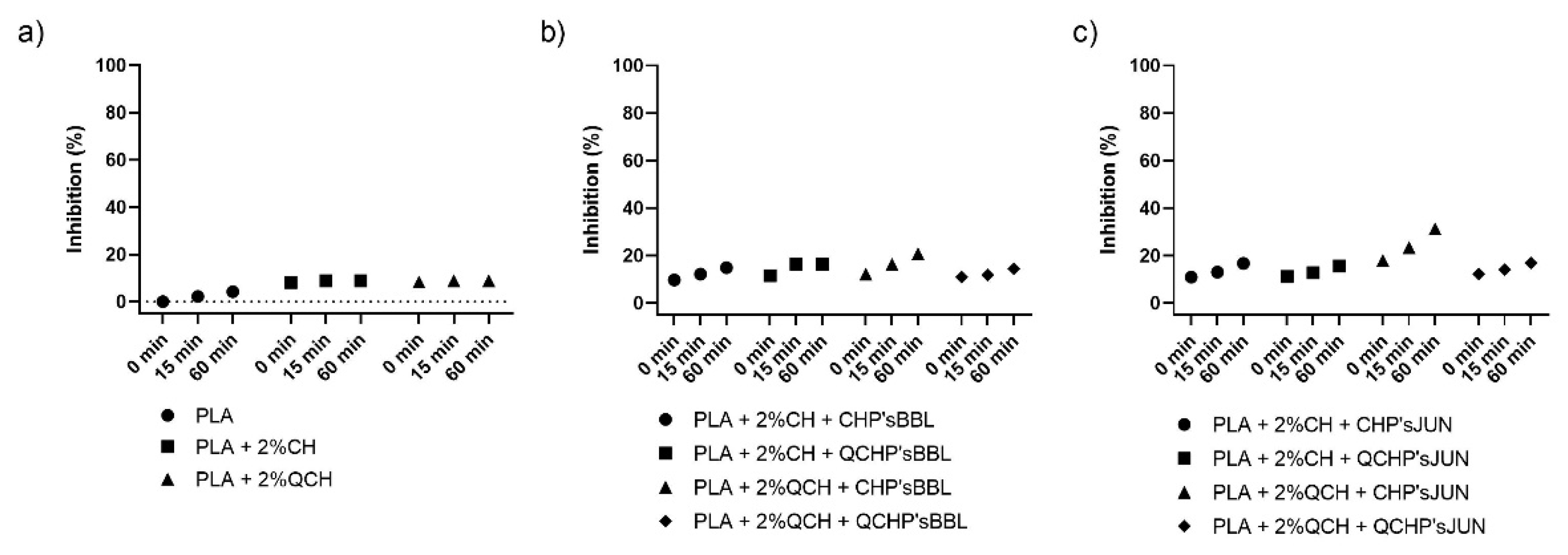
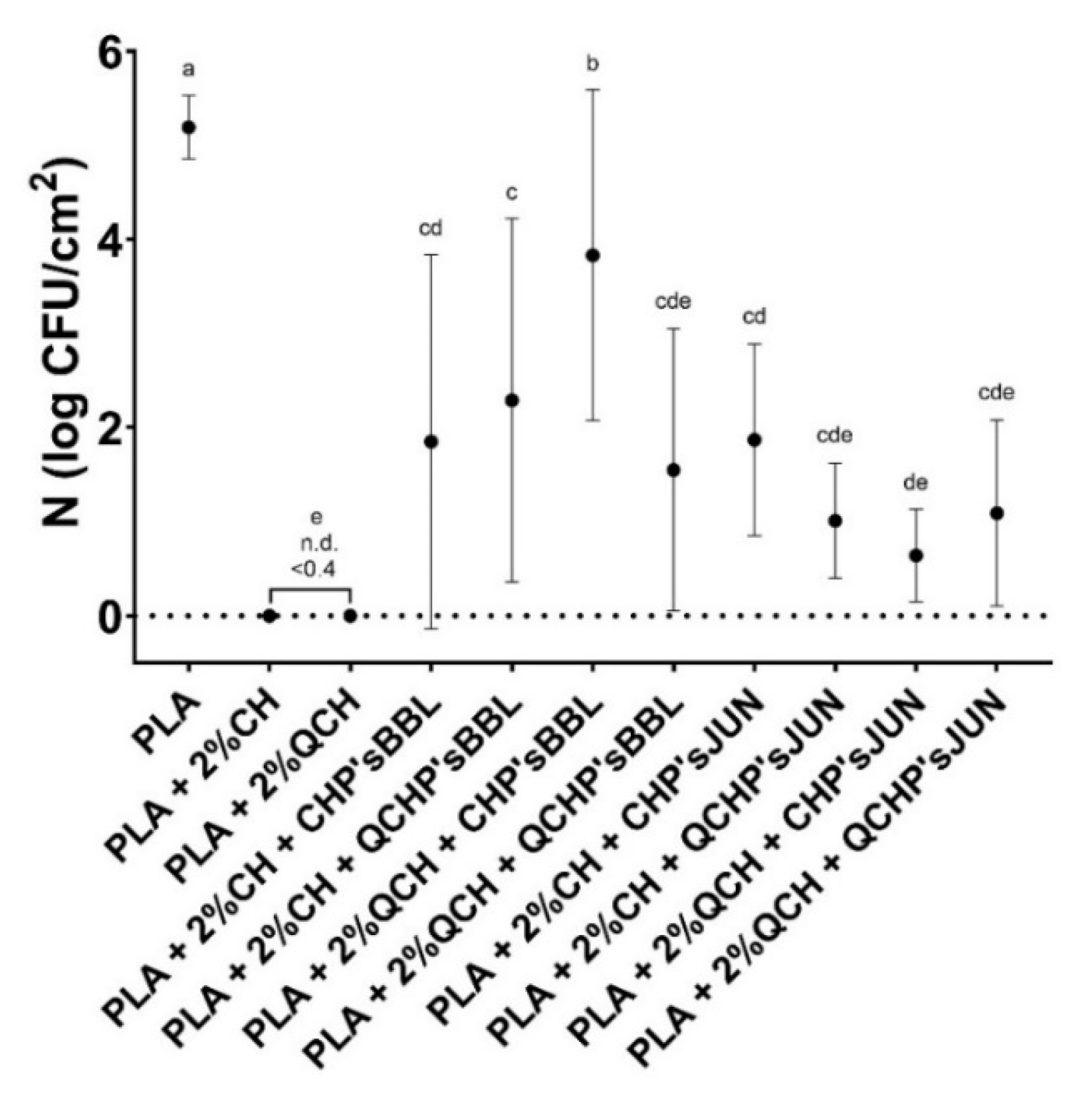
| Solutions | Acronym |
|---|---|
| 1% Primary chitosan | CH |
| 1% Quaternary chitosan | QCH |
| 2% Primary chitosan | 2% CH |
| 2% Quaternary chitosan | 2% QCH |
| Primary chitosan particles | CHP |
| Quaternary chitosan particles | QCHP |
| Blackberry leaves extract | BBL |
| Juniper needles extract | JUN |
| Sodium tripolyphosphate | TPP |
| Description of the Samples | Sample Notation |
|---|---|
| PLA with no coatings | PLA |
| PLA applicate with 2% CH | PLA + 2% CH |
| PLA applicate with 2% QCH | PLA + 2% QCH |
| Samples with primary chitosan as first layer | |
| PLA applicate with 2% CH and CHP’sJUN | PLA + 2% CH + CHP’JUN |
| PLA applicate with 2% CH and QCHP’sJUN | PLA +2% CH + QCHP’s JUN |
| PLA applicate with 2% CH and CHP’sBBL | PLA + 2% CH + CHP’sBBL |
| PLA applicate with 2% CH and QCHP’sBBL | PLA + 2% CH + QCHP’sBLL |
| Samples with quaternary chitosan as first layer | |
| PLA applicate with 2% QCH and CHP’sJUN | PLA + 2% QCH + CHP’sJUN |
| PLA applicate with 2% QCH and QCHP’sJUN | PLA + 2% QCH + QCHP’sJUN |
| PLA applicate with 2% QCH and CHP’sBBL | PLA + 2% QCH + CHP’sBBL |
| PLA applicate with 2% QCH and QCHP’sBBL | PLA + 2% QCH + QCHP’sBBL |
| Sample | HD [nm] | PDI [%] | ZP [mV] | SD |
|---|---|---|---|---|
| CHP | 358 | 16.8 | 36 | 0.2 |
| QCHP | 239.9 | 17.5 | 33 | 0.3 |
| CHP’sBBL | 20,402 | 39.5 | 12 | 0.2 |
| QCHP’sBBL | 14,201 | 27.2 | 24.8 | 0.3 |
| CHP’sJUN | 16,264 | 23.7 | 14.9 | 0.4 |
| QCHP’sJUN | 8980 | 29.4 | 39.8 | 0.9 |
| Samples | SCA (α/°) | Difference (%) |
|---|---|---|
| PLA | 77.56 ± 1.61 a | / |
| PLA + 2% CH | 80.39 ± 2.23 a | −3.66 ± 2.23 |
| PLA + 2% QCH | 78.69 ± 4.02 a | −1.47± 4.02 |
| PLA + 2% CH + CHP’sBBL | 40.00 ± 0.53 de | 48.43 ± 0.53 |
| PLA+2% CH+QCHP’sBBL | 42.66 ± 2.09 cd | 44.99 ± 2.09 |
| PLA + 2% QCH + CHP’sBBL | 44.96 ± 0.24 c | 42.03 ± 0.24 |
| PLA + 2QCH + QCHP’sBBL | 30.33 ± 2.49 f | 60.90 ± 2.49 |
| PLA + 2% CH + CHP’sJUN | 50.41 ± 1.92 b | 35.00 ± 1.92 |
| PLA + 2% CH + QCHP’sJUN | 38.84 ± 3.34 de | 49.92 ± 3.34 |
| PLA + 2% QCH + CHP’sJUN | 37.67 ± 2.30 e | 51.43 ± 2.30 |
| PLA + 2% QCH + QCHP’sJUN | 37.61 ± 1.34 e | 51.51 ± 1.34 |
| Sample | C | N | O | Na | Mg | Si | P | Cl | Ca | S | K |
|---|---|---|---|---|---|---|---|---|---|---|---|
| PLA + 2% CH + CHP’sJUN | 65.9 | 3.4 | 27.1 | / | 3.2 | 0.2 | 0.3 | ||||
| PLA + 2% CH + QCHP’sJUN | 65.8 | 4.9 | 27.8 | / | 0.8 | 0.5 | 0.2 | ||||
| PLA + 2% QCH + CHP’sJUN | 65.2 | 3.8 | 28.8 | 0.6 | 0.6 | 0.3 | 0.3 | 0.5 | |||
| PLA + 2% QCH + QCHP’sJUN | 66.8 | 2.7 | 29.7 | 0.3 | 0.2 | 0.3 | |||||
| After Desorption | |||||||||||
| PLA + 2% CH + CHP’sJUN | 62.8 | 1.5 | 34.4 | 1 | 0.2 | ||||||
| PLA + 2% CH + QCHP’sJUN | 63.8 | 3 | 31.4 | 0.9 | 0.3 | 0.6 | |||||
| PLA + 2% QCH + CHP’sJUN | 63.1 | 34.2 | 1.5 | 0.2 | 0.3 | 0.1 | 0.5 | ||||
| PLA + 2% QCH + QCHP’sJUN | 63.5 | 2.1 | 32.6 | 0.7 | 0.4 | 0.6 | |||||
| Difference | |||||||||||
| PLA + 2% CH + CHP’sJUN | −3.1 | −1.9 | 7.3 | −1 | 0 | −0.1 | |||||
| PLA + 2% CH + QCHP’sJUN | −2 | −1.9 | 3.6 | −0.9 | −0.2 | 0.6 | |||||
| PLA + 2% QCH + CHP’sJUN | −2.1 | −3.8 | 5.4 | 0.9 | −0.1 | 0 | |||||
| PLA + 2% QCH + QCHP’sJUN | −3.3 | −0.6 | 2.9 | 0.7 | 0.2 | 0.6 | |||||
| Sample | C | N | O | Na | Mg | Si | P | Cl | Ca | S | K |
|---|---|---|---|---|---|---|---|---|---|---|---|
| PLA + 2%CH + CHP’sBBL | 62.9 | 2.1 | 33.2 | 0.4 | 0.3 | 0.2 | 0.6 | 0.3 | |||
| PLA + 2%CH + QCHP’sBLL | 64.4 | 2.2 | 31 | 1 | 0.3 | 1 | |||||
| PLA + 2%QCH + CHP’sBBL | 66.7 | 2.8 | 29 | 0.7 | 0.6 | 0.2 | |||||
| PLA + 2QCH + QCHP’sBBL | 66.4 | 2.1 | 28.9 | 0.5 | 1.1 | 0.9 | |||||
| After Desorption | |||||||||||
| PLA + 2%CH + CHP’sBBL | 62.6 | 4.4 | 30.6 | 0.4 | 1.1 | 0.6 | 0.2 | 0.1 | |||
| PLA + 2%CH + QCHP’sBLL | 64 | 4.5 | 30.2 | 0.6 | 0.4 | 0.3 | |||||
| PLA + 2%QCH + CHP’sBBL | 67.1 | 3.6 | 26.9 | 1.6 | 0.6 | 0.2 | |||||
| PLA + 2QCH + QCHP’sBBL | 67 | 4.9 | 26.9 | 0.3 | 0.2 | 0.5 | 0.2 | ||||
| Difference | |||||||||||
| PLA + 2%CH + CHP’sBBL | −0.3 | 2.3 | −2.6 | 0 | 0.3 | 0.9 | 0 | −0.1 | |||
| PLA + 2%CH + QCHP’sBLL | −0.4 | 2.3 | −0.8 | −1 | 0.3 | 0.4 | −1 | ||||
| PLA + 2%QCH + CHP’sBBL | 0.4 | 0.8 | −2.1 | 0 | 0.9 | −0.6 | 0.4 | ||||
| PLA + 2QCH + QCHP’sBBL | 0.6 | 2.8 | −2 | −0.5 | −0.8 | 0.2 | −0.4 | ||||
| Sample | Bacteria | |
|---|---|---|
| Staphylococcus aureus ATCC 25923 | ||
| R | R (%) | |
| PLA | / | / |
| PLA + 2%CH | >4.80 | 100.00 |
| PLA + 2%QCH | >4.80 | 100.00 |
| PLA + 2%CH + CHP’sBBL | 3.34 | 99.95 |
| PLA + 2%CH + QCHP’sBLL | 2.90 | 99.87 |
| PLA + 2%QCH + CHP’sBBL | 1.36 | 95.64 |
| PLA + 2QCH + QCHP’sBBL | 3.65 | 99.98 |
| PLA + 2%CH + CHP’sJUN | 3.32 | 99.95 |
| PLA + 2%CH + QCHP’sJUN | 4.19 | 99.99 |
| PLA + 2%QCH + CHP’sJUN | 4.55 | 100.00 |
| PLA + 2%QCH + QCHP’sJUN | 4.11 | 99.99 |
Publisher’s Note: MDPI stays neutral with regard to jurisdictional claims in published maps and institutional affiliations. |
© 2022 by the authors. Licensee MDPI, Basel, Switzerland. This article is an open access article distributed under the terms and conditions of the Creative Commons Attribution (CC BY) license (https://creativecommons.org/licenses/by/4.0/).
Share and Cite
Zemljič, L.F.; Glaser, T.K.; Plohl, O.; Anžel, I.; Šimat, V.; Čagalj, M.; Mežnar, E.; Malin, V.; Sterniša, M.; Možina, S.S. Biomass-Derived Plant Extracts in Macromolecular Chitosan Matrices as a Green Coating for PLA Films. J. Funct. Biomater. 2022, 13, 228. https://doi.org/10.3390/jfb13040228
Zemljič LF, Glaser TK, Plohl O, Anžel I, Šimat V, Čagalj M, Mežnar E, Malin V, Sterniša M, Možina SS. Biomass-Derived Plant Extracts in Macromolecular Chitosan Matrices as a Green Coating for PLA Films. Journal of Functional Biomaterials. 2022; 13(4):228. https://doi.org/10.3390/jfb13040228
Chicago/Turabian StyleZemljič, Lidija Fras, Tjaša Kraševac Glaser, Olivija Plohl, Ivan Anžel, Vida Šimat, Martina Čagalj, Eva Mežnar, Valentina Malin, Meta Sterniša, and Sonja Smole Možina. 2022. "Biomass-Derived Plant Extracts in Macromolecular Chitosan Matrices as a Green Coating for PLA Films" Journal of Functional Biomaterials 13, no. 4: 228. https://doi.org/10.3390/jfb13040228
APA StyleZemljič, L. F., Glaser, T. K., Plohl, O., Anžel, I., Šimat, V., Čagalj, M., Mežnar, E., Malin, V., Sterniša, M., & Možina, S. S. (2022). Biomass-Derived Plant Extracts in Macromolecular Chitosan Matrices as a Green Coating for PLA Films. Journal of Functional Biomaterials, 13(4), 228. https://doi.org/10.3390/jfb13040228










